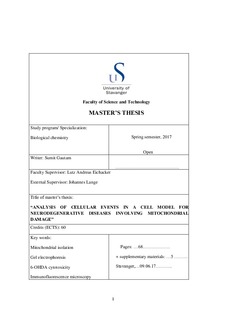| dc.description.abstract | Mitochondria are highly dynamic organelles, with an essential role in proper cell function. Increasing evidence points towards a key role of mitochondria and its bioenergetic state for pathogenesis of neurodegenerative diseases like Parkinson´s disease. Nonetheless, the study of defects in mitochondrial dynamics has been linked with a better understanding of the pathophysiology of such an enigmatic disease. Here, the isolation of pure mitochondria from neuronal cells was investigated, since it is a crucial step to perform proteomics research on the organelle, which can be helpful in exploring the intricate role of mitochondria in neurodegeneration. In addition, the influence of 6-OHDA, proven to have cytotoxic action in neuronal cells has been tested, since the precise underlying mechanism is unknown.
Several mitochondria isolation and extraction methods were tested. Dounce homogenization technique has been found to be the most promising technique and was pursued further to improve the protocol and isolate the mitochondria from neuroblastoma cells, SHSY5Y. Moreover, the cytotoxic effect of neurotoxin 6-OHDA on SHSY5Y cells, was investigated using the XTT assay method, to find the concentration for 6-OHDA that impairs, but not kills the cells (aiming at 50% survival). The effect of 6-OHDA on different proteins of neuronal cells like TOM20, MAP2, IL-6Rα and alpha-synuclein were studied using immunofluorescence microscopy. Here, the cytotoxic effect of 6-OHDA on cell viability in SHSY5Y cells were reproduced. Interestingly, this neurotoxin was also found likely to have detrimental effects on mitochondrial proteins like TOM20, microtubular protein MAP2, IL-6Rα and alpha-synuclein. We discuss that 6OHDA can directly or indirectly affect the neuronal cells which might lead to cell death. The underlying mechanism behind the effects of 6-OHDA on the cell proteins remained elusive. Further detailed studies of 6-OHDA action on neuronal cell should be performed on the molecular level to develop an appropriate therapeutic strategy for the neurodegenerative diseases. | nb_NO |
